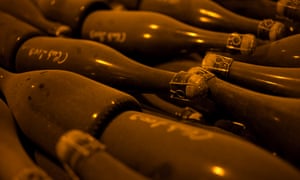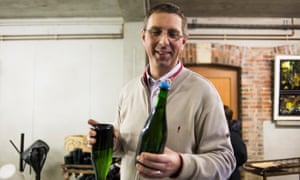For some vineyards in France, employing green practices in their winemaking is as important as protecting the use of the term ‘champagne’

As revelers around the world ring in the new year with glasses of champagne tonight, they’re probably not toasting to the sustainable agricultural methods that went into some of the bottles.
But for some vineyards in France – where earlier this month nearly 200 nations signed a landmark deal to limit climate change – employing green practices in their winemaking is as important as protecting the use of the term “champagne”, which applies only to the bubbly produced in a region of France that bears the same name.
Climate change is prompting some farmers in this celebrated region to switch to more eco-friendly techniques which, they hope, will also enable their champagne to command higher prices from consumers who care about whether what they are drinking is sustainably produced.
In 2014, champagne production was valued at €4.5bn ($4.8bn) per year. Nearly 16,000 winegrowers produced grapes for 300 champagne houses, which sold 307m bottles that year. In 2003, the champagne industry emitted 200,000 metric tons of carbon dioxide annually.
Figuring out how to keep his vineyards productive for decades to come has driven Jean-Pierre Vazart, a third-generation farmer, to adopt more eco-friendly practices. His vineyard, Vazart-Coquart & Fils, overlooks the Blancs de Blancs region of Champagne in northeast France.
“We must think about all these little things to have sustainable thinking,” Vazart says. “For us, it’s very important in our carbon calculation.”
Standing in a newly constructed building in Chouilly, Champagne, Vazart gives a tour of his grape pressing facility. The second floor of the building makes use of natural light to brighten up the space during the day, and efficient insulation keeps the building warm. The floor below houses a new, more energy efficient grape press. Vazart is pouring his profits into making his champagne business more sustainable.
“In harvest, this place is filled with grapes, waiting for the pressing,” he says. Next year, he plans to rebuild the winery itself. “I want to change a lot.”
 Facebook Twitter Pinterest
Facebook Twitter Pinterest While other grape-growing regions already see the impact of climate change – too many warm days for grapes that love cool climate in California, for example – champagne growers so far haven’t felt the effect. In fact, they have found that warmer weather has been helpful. It has reduced fatal frost damage to the grapes. The grapes are ripening with a higher alcohol level and lower acidity, making it easier for winemakers to meet regulations.
But Vazart and his compatriots are not kicking back with glasses of their own bubbly to celebrate. They know that in the long term, with forecasts of extreme drought and storms, sustainable practices will be critical to keep their centuries-old tradition alive.
Champagne is already a regulated business from an environmental perspective. Some 330m tons of grape clusters are plucked every year in Champagne; these clusters are shorn from the vines by hand and carried carefully to the press, where they are squeezed without being separated from the branch. All producers are required by French law to recycle 100% of discarded material from their grape-crushing endeavors, including the water used to wash down the press. As much as 90% of plastics and glass from champagne production is recycled.
Vazart and others want to do more. Earlier this year, the French Ministry of Agriculture approved a sustainable vinegrowing certification program, named Viticulture Durable en Champagne, advocated by champagne makers like Vazart. The award supplements an earlier certification approved by the French government in 2012, the High Environmental Value (HVE) certificate, which can be used by farmers in all agricultural industries – not just wine.
Such sustainable practices go beyond recycling waste, and Vazart has already adopted many of them. For instance, he increases biodiversity in his fields by planting grasses and hedges for insects to nest and feed on grape pests. He also spreads the pheromones of female butterflies around his vines to induce what he calls “sexual confusion” – caterpillars are too frenzied by the scent to burrow into grapes and lay eggs in them.
“No egg, no caterpillar, no problem,” Vazart says.
After introducing these eco-friendly practices in the early 2000s, Jean-Pierre’s village saw a dramatic 90% drop in the use of pesticides, while the whole Champagne region saw a 50% drop. Even though they have been using those practices for years, they will not get government certification for their effort.
Other less sexy but no less critical changes covered by the sustainability initiative include preventing soil erosion, managing water supplies and runoff, constructing more efficient buildings, like Vazart’s new facility, and reducing transportation emissions. Champagne growers have managed to reduce the carbon footprint of each bottle by 15% since 2003, even as production has increased – thanks in part to new bottles that weigh 7% less.
Eco-friendly practices don’t just reduce environmental damage caused by farming, Vazart argues; they add value to the land by increasing biodiversity. And all of the grape clusters discarded after pressing fuel other industries – for instance, city buses in Paris run, in part, on ethanol made with wastes from press grapes.
According to the Center for Biological Diversity, the conservation of agricultural biodiversity is a “key option for the adaptation to climate change”. The practices employed by Vazart and his fellow farmers both combat the effects of climate change, which include more erratic weather patterns and stronger storms, and help adapt to a changing world.
The grass and hedges Vazart planted, for instance, aren’t just a haven for helpful insects; they also prevent soil erosion during times of heavy rain. Curbing emissions from shipping bottles around the globe – which accounts for much of Champagne’s carbon footprint – will reduce the emissions created by the wine industry.
When he was younger, Vazart wanted to work in a completely different field – perhaps with computers. But when he began working alongside his father, he came to love it.
“It’s not a job. It’s a life. Now, it’s the only thing I could do,” he says.
Creating sustainably made wine isn’t just about dealing with climate change. Some farmers, including Vazart, believe it will also enable them to fetch higher prices for their labor.
According to a Food Policy study, sustainability labels don’t significantly change consumer behavior; such certifications only have an impact on people who are already concerned about the environment. Meanwhile, according to a market analysis report by the Canadian government, 61% of French people think it’s important to buy socially responsible products and 45% say they have altered their behavior to buy more of those products.
“We’re not trying to produce more bottles. We’re trying to produce better bottles that consumers will pay more for,” says Thibaut Le Mailloux, communications director of the Champagne Committee, the trade association that helped create the rigorous sustainability certification approved by France’s Ministry of Agriculture earlier this year.
“Consumers are more and more demanding greener products,” Le Mailloux says. “We want to prove the efforts we have done because it gives an even better image of Champagne.”
But switching to eco-friendly practices costs money, an expense that can be too great for some farmers. Agricultural producers with slimmer margins point out that refitting their operations would involve significant costs. Improving wastewater treatment alone in Champagne cost €80m ($86m), and researching and testing environmental initiatives, like new bottles, can cost one house anywhere between €500,000 to €1m ($540,000–$1.1m).
Many agricultural producers – from dairy and meat producers to wheat and fruit farmers – are already feeling the burn of climate change with more extreme weather patterns and less predictable seasons ruining crops and affecting prices. Taking on huge costs to change their operations is just not a feasible option.
Le Mailloux acknowledges that champagne makers tend to have deeper pockets than other agricultural producers, so they can afford to take risks on innovative practices.
However, despite the difficulties facing France’s agricultural industry, Le Mailloux hopes that more farmers will eventually incorporate sustainable growing methods in order to stay in business.
“We hope there will always be a reason to celebrate and drink champagne,” he says.
• This article is part of a special report by The GroundTruth Project. Read the rest of the project, Climate of Hope, at The GroundTruth Project.

